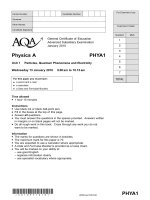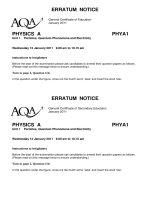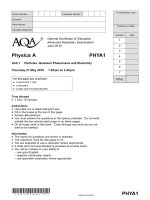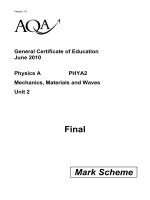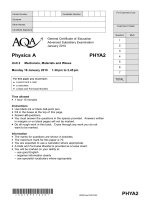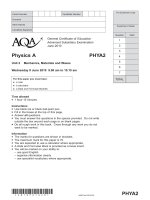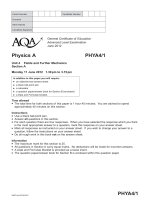- Trang chủ >>
- Khoa Học Tự Nhiên >>
- Vật lý
AQA PHYA4 1 w QP JUN10
Bạn đang xem bản rút gọn của tài liệu. Xem và tải ngay bản đầy đủ của tài liệu tại đây (79.16 KB, 12 trang )
WMP/Jun10/PHYA4/1
PHYA4/1
Centre Number
Surname
Other Names
Candidate Signature
Candidate Number
General Certificate of Education
Advanced Level Examination
June 2010
Time allowed
●
The total time for both sections of this paper is 1 hour 45 minutes. You are advised to spend
approximately 45 minutes on this section.
Instructions
●
Use black ink or black ball-point pen. Do not use pencil.
●
Answer all questions in this section.
●
For each question there are four responses. When you have selected the response which you think
is the most appropriate answer to a question, mark this response on your answer sheet.
●
Mark all responses as instructed on your answer sheet. If you wish to change your answer to a
question, follow the instructions on your answer sheet.
●
Do all rough work in this book not on the answer sheet.
Information
●
The maximum mark for this section is 25.
●
Section A and Section B of this paper together carry 20% of the total marks for Physics Advanced.
●
All questions in Section A carry equal marks. No deductions will be made for incorrect answers.
●
A Data and Formulae Booklet is provided as a loose insert.
●
The question paper/answer book for Section B is enclosed within this question paper.
In addition to this paper you will require:
●
an objective test answer sheet
●
a black ink or black ball-point pen
●
a calculator
●
a question paper/answer book for Section B (enclosed)
●
a Data and Formulae Booklet.
Physics A PHYA4/1
Unit 4 Fields and Further Mechanics
Section A
Friday 18 June 2010 9.00 am to 10.45 am
WMP/Jun10/PHYA4/1
2
1 Which one of the following statements is correct?
The force acting on an object is equivalent to
A its change of momentum.
B the impulse it receives per second.
C the energy it gains per second.
D its acceleration per metre.
2 The graph shows how the force on a glider of mass 2000 kg changes with time as it is launched
from a level track using a catapult.
Assuming the glider starts at rest what is its velocity after 40 s?
A 2.5 m s
–1
B 10 m s
–1
C 50 m s
–1
D 100 m s
–1
3 A gas molecule of mass m in a container moves with velocity v. If it makes an elastic collision
at right angles to the walls of the container, what is the change in momentum of the molecule?
A zero
B mv
C mv
D 2 mv
Multiple choice questions
Each of Questions 1 to 25 is followed by four responses, A, B, C and D. For each question select
the best response and mark its letter on the answer sheet.
You are advised to spend approximately 45 minutes on this section.
1
2
5.0
4.0
3.0
force
/ kN
2.0
1.0
0
0 5 10 15 20
time
/ s
25 30 35 40
3
Turn over
ᮣ
WMP/Jun10/PHYA4/1
4 A mass on the end of a string is whirled round in a horizontal circle at increasing speed until
the string breaks. The subsequent path taken by the mass is
A a straight line along a radius of the circle.
B a horizontal circle.
C a parabola in a horizontal plane.
D a parabola in a vertical plane.
5 A particle of mass m moves in a circle of radius r at uniform speed, taking time T for each
revolution. What is the kinetic energy of the particle?
A
B
C
D
6 A body moves with simple harmonic motion of amplitude 0.90 m and period 8.9 s. What is the
speed of the body when its displacement is 0.70 m?
A 0.11 m s
–1
B 0.22 m s
–1
C 0.40 m s
–1
D 0.80 m s
–1
Turn over for the next question
π
2
mr
T
2
π
2
mr
2
T
2
2π
2
mr
2
T
2π
2
mr
2
T
2
WMP/Jun10/PHYA4/1
4
7 Which graph, A to D, shows the variation of the kinetic energy, E
k
, with displacement x for a
particle performing simple harmonic motion?
8 The time period of oscillation of a simple pendulum of length l is the same as the time period
of oscillation of a mass M attached to a vertical spring. The length and mass are then changed.
Which row, A to D, in the table would give a simple pendulum with a time period twice that of
the spring oscillations?
new pendulum length new mass on spring
A 2l 2M
B 2l
C 2M
D
M
2
M
2
l
2
l
2
E
k
0
A
x
E
k
0
C
x
E
k
0
B
x
E
k
0
D
x
5
Turn over
ᮣ
WMP/Jun10/PHYA4/1
9 A projectile moves in a gravitational field. Which one of the following is a correct statement
about the gravitational force acting on the projectile?
A The force is in the direction of the field.
B The force is in the opposite direction to that of the field.
C The force is at right angles to the field.
D The force is at an angle between 0° and 90° to the field.
10 The gravitational potential difference between the surface of a planet and a point P, 10 m above
the surface, is 8.0 J kg
–1
. Assuming a uniform field, what is the value of the gravitational field
strength in the region between the planet’s surface and P?
A 0.80 N kg
–1
B 1.25 N kg
–1
C 8.0 N kg
–1
D 80 N kg
–1
11 An artificial satellite of mass m is in a stable circular orbit of radius r around a planet of
mass M. Which one of the following expressions gives the speed of the satellite?
G is the universal gravitational constant.
A
B
C
D
1
2
Gm
r
()
1
2
GM
r
()
Gm
r
3
2
Gm
r
()
WMP/Jun10/PHYA4/1
6
12 A small object O carrying a charge +Q is placed at a distance d from a metal plate that has an
equal and opposite charge. The object is acted on by an electrostatic force F.
Which one of the following expressions has the same unit as F?
A
B
C
D
13
The diagram shows two charges, +4 µC and –16 µC, 120 mm apart. What is the distance from
the +4 µC charge to the point between the two charges where the resultant electric potential is
zero?
A 24 mm
B 40 mm
C 80 mm
D 96 mm
ε
0
Q
2
d
ε
0
Q
2
d
2
Q
2
ε
0
d
2
Q
2
ε
0
d
+Q
object O
d
metal plate
120 mm
–16
µC+ 4 µC
7
14 The diagram shows four point charges at the corners of a square of side 2a. What is the
electric potential at P, the centre of the square?
A
B
C
D
15 A 1 µF capacitor is charged using a constant current of 10 µA for 20 s. What is the energy
finally stored by the capacitor?
A 2 × 10
–3
J
B 2 × 10
–2
J
C 4 × 10
–2
J
D 4 × 10
–1
J
16 A 2.0 mF capacitor, used as the backup for a memory unit, has a potential difference of 5.0 V
across it when fully charged. The capacitor is required to supply a constant current of 1.0 µA
and can be used until the potential difference across it falls by 10%. How long can the
capacitor be used for before it must be recharged?
A 10 s
B 100 s
C 200 s
D 1000 s
Turn over
ᮣ
WMP/Jun10/PHYA4/1
Q
2 2πε
0
a
Q
2πε
0
a
Q
2πε
0
a
Q
4πε
0
a
P
2a
2a
–Q+Q
+Q+Q
WMP/Jun10/PHYA4/1
8
17 When switch S in the circuit is closed, the capacitor C is charged by the battery to a pd V
0
.
The switch is then opened until the capacitor pd decreases to 0.5 V
0
, at which time S is closed
again. The capacitor then charges back to V
0
.
Which graph best shows how the pd across the capacitor varies with time, t, after S is opened?
S
R
R
C
0
0 t
pd
A
V
0
0
0 t
pd
B
V
0
0
0 t
pd
C
V
0
0
0 t
pd
D
V
0
9
18 When a capacitor discharges through a resistor it loses 50% of its charge in 10 s. What is the
time constant of the capacitor-resistor circuit?
A 0.5 s
B 5s
C 14 s
D 17 s
19 The diagram shows a rigidly-clamped straight horizontal current-carrying wire held mid-way
between the poles of a magnet on a top pan balance. The wire is perpendicular to the magnetic
field direction.
The balance, which was zeroed before the switch was closed, reads 112 g after the switch is
closed. If the current is reversed and doubled, what will be the new reading on the balance?
A –224 g
B –112 g
C zero
D 224 g
20 An electron moving with a constant speed enters a uniform magnetic field in a direction at
right angles to the field. What is the subsequent path of the electron?
A A straight line in the direction of the field.
B A straight line in a direction opposite to that of the field.
C A circular arc in a plane perpendicular to the direction of the field.
D An elliptical arc in a plane perpendicular to the direction of the field.
Turn over
ᮣ
WMP/Jun10/PHYA4/1
112
A
WMP/Jun10/PHYA4/1
10
21 A jet of air carrying positively charged particles is directed horizontally between the poles of a
strong magnet, as shown in the diagram.
In which direction are the charged particles deflected?
A upwards
B downwards
C towards the N pole of the magnet
D towards the S pole of the magnet
22 Which one of the following could not be used as a unit of force?
A ATm
B Ws
–2
C kg m s
–2
D Jm
–1
NS
positively
charged
particles
11
Turn over
ᮣ
WMP/Jun10/PHYA4/1
23 The graph shows how the magnetic flux passing through a loop of wire changes with time.
What feature of the graph represents the magnitude of the emf induced in the coil?
A the area enclosed between the graph line and the time axis
B the area enclosed between the graph line and the magnetic flux axis
C the inverse of the gradient of the graph
D the gradient of the graph
24 A coil rotating in a magnetic field produces the following voltage waveform when connected to
an oscilloscope.
With the same oscilloscope settings, which one of the following voltage waveforms would be
produced if the coil were rotated at twice the original speed?
0
0
magnetic
flux
time
1 cm
2 cm
2 cm
0.5 cm
0.5 cm
A
C
B
D
WMP/Jun10/PHYA4/1
12
Copyright © 2010 AQA and its licensors. All rights reserved.
25 A 230 V, 60 W lamp is connected to the output terminals of a transformer which has a 200 turn
primary coil and a 2000 turn secondary coil. The primary coil is connected to an ac source
with a variable output pd. The lamp lights at its normal brightness when the primary coil is
supplied with an alternating current of 2.7 A.
What is the percentage efficiency of the transformer?
A 3%
B 10%
C 97%
D 100%
END OF QUESTIONS

